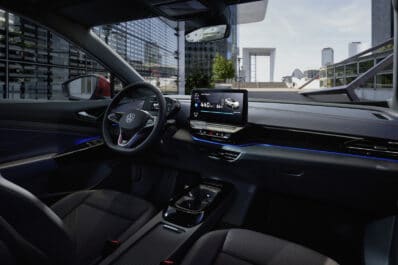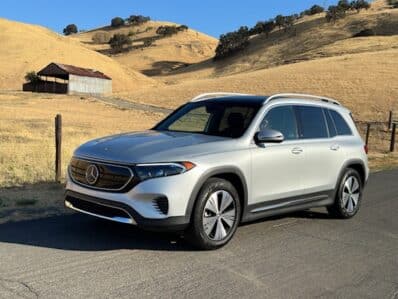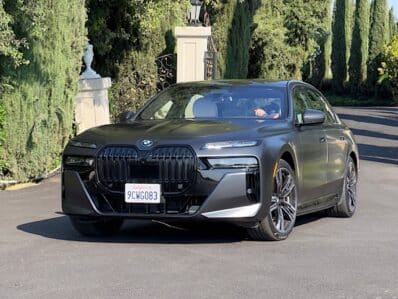As the 2021 model year draws to a close, there are just 13 battery-electric vehicles available on the U.S. market. By the end of next year, that’s expected to quadruple, to 50 or more. Among the most eagerly awaited of the new offerings is the Rivian R1T.
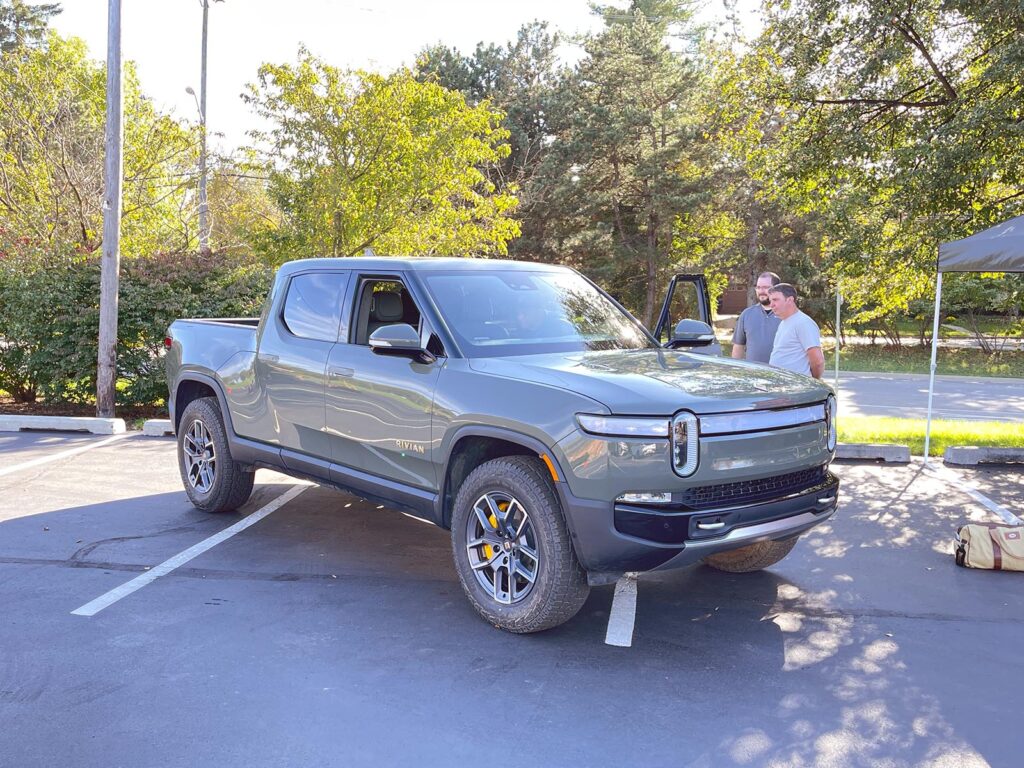
This full-size pickup is the first in a wave of all-electric trucks set to come to market in the near future — a list that includes the GMC Hummer SUT EV, the Ford Lightning and the Tesla Cybertruck. Whether Rivian gets the classic “first-mover advantage” remains to be seen, but there’s certainly plenty of buzz building around the R1T.
I readily took my first opportunity to drive the truck on a brisk autumn morning in Ann Arbor, Michigan this week, climbing up into the cab just as dawn was breaking. My time behind the wheel wasn’t as long as I’d have liked but still provided significant insight into what Rivian is offering.
Overview
The Rivian R1T is a full-size battery-electric pickup that will compete with a number of similarly sized trucks coming to market. The Ford F-150 Lightning due out in mid-2022 is the most direct, at least from a form factor, though Rivian’s entry delivers many of the over-the-top features we’ll also find in the new GMC Hummer. While the R1T has a distinctive look, it adopts classic pickup dimensions and will offer plenty of cargo and towing capacity — in combination, more than 11,000 pounds.
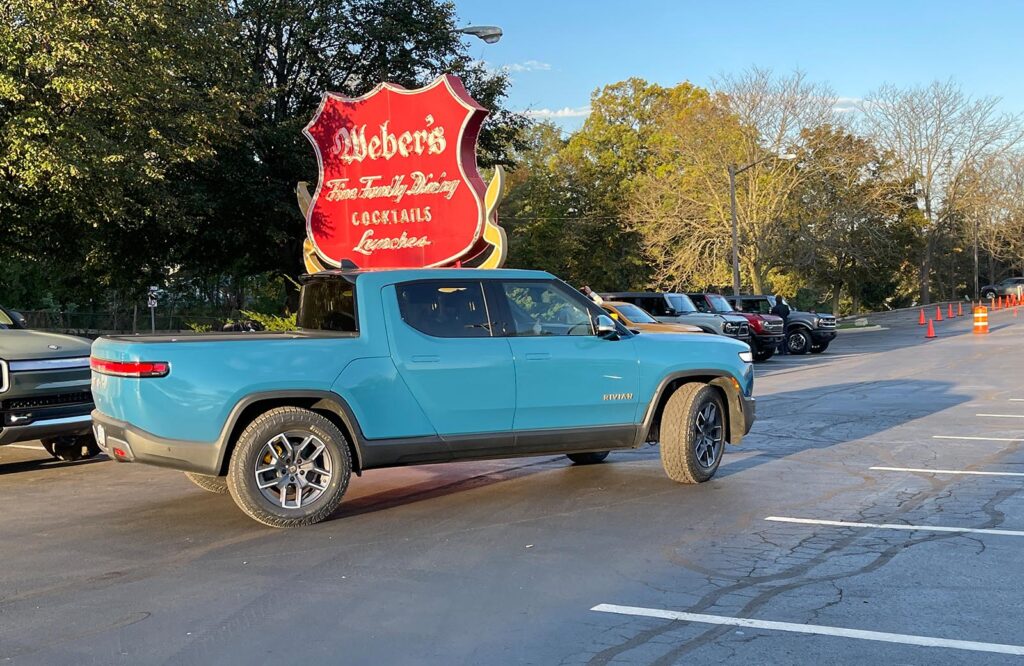
But a closer look reveals how Rivian has done an impressive job of starting from scratch with an all-new, skateboard-like platform for the R1T. By moving the hefty battery pack and motors under the load floor, it freed up space for all sorts of useful nooks and storage spaces not normally available in a full-size pickup.
The truck will be offered in a variety of different configurations, including battery packs running up to around 180 kilowatt hours. In what is becoming the norm in the battery-electric vehicle market, however, the 2022 Rivian R1T debuts with a single, $73,000 Launch Edition that comes fairly well loaded with features, from sophisticated wood and vegan leather interior trim to a Level 2 driving assistance system.
The Launch Edition features an 800 horsepower, four-motor drivetrain delivering the sort of launch feel few conventional, gas-powered models can come close to matching. And it draws energy from Rivian’s mid-range, 135 kWh battery pack that will deliver an EPA-estimated 314 miles of range — though that number is likely to be impacted significantly should you load up the cargo bed or hitch up a trailer.
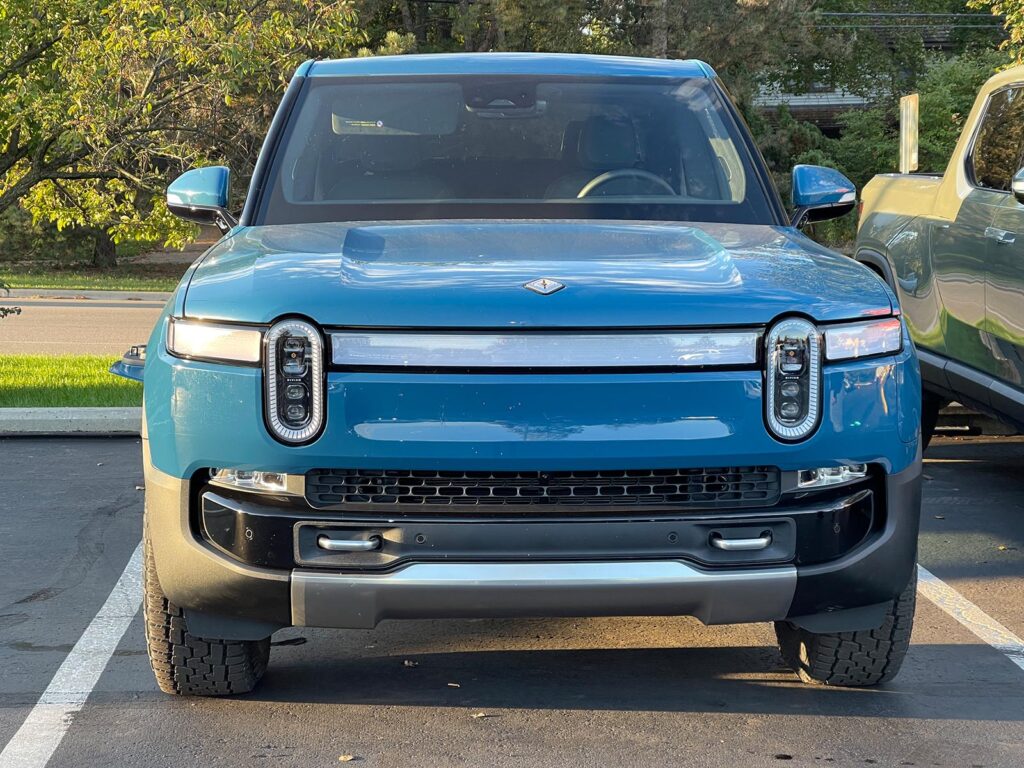
Additional versions of the R1T, including the Adventure and Explore editions, will begin rolling out in 2022.
Exterior
This no Cybertruck. Spot the Rivian R1T from a side profile and you might not, at least initially, realize it’s a completely different — read: all-electric — pickup from an all-new manufacturer. The basic shape is relatively similar to more conventional full-size pickups — with a few key exceptions.
From a front view, it’s much more obvious this is an entirely new entry, with the broad light bar that stretches across the pickup’s nose, just below the hood, wrapping into the front quarter panels. The R1T also features distinctive vertical headlights. And, the reality is the “grille” really isn’t. Like other EVs, there’s no powertrain under the hood to feed air into, though intakes under the bumper do provide the air necessary to cool the truck’s motors and battery pack.
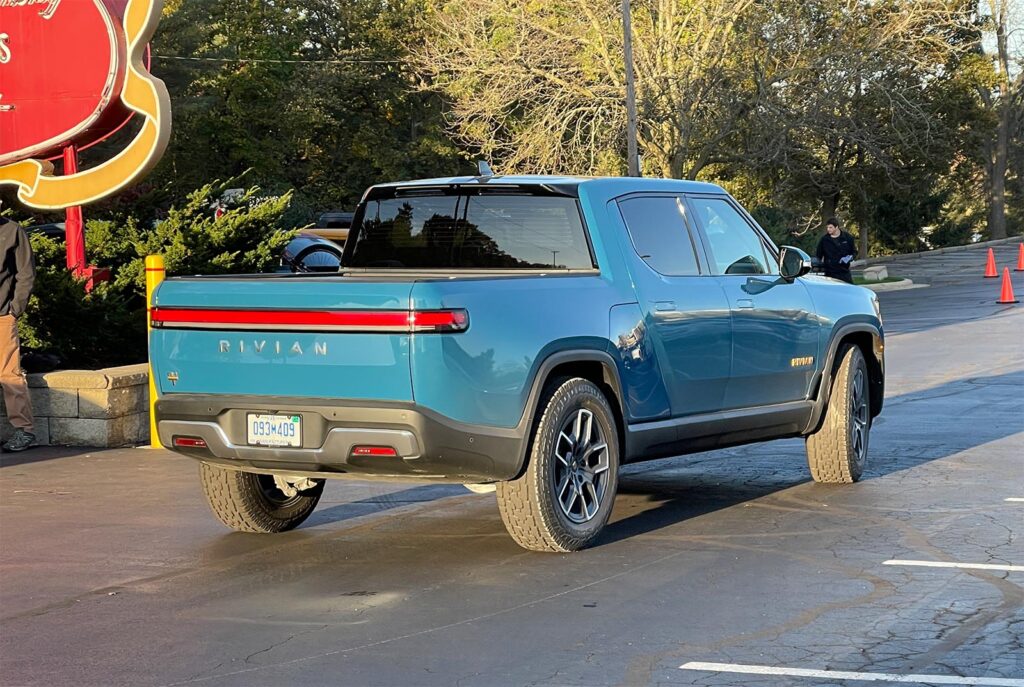
A quick walkaround reveals a long cutline stretching from the rear doors to the wheel wells. Tap a switch and one of these doors will pop open, revealing a hidden “Gear Tunnel” storage compartment that stretches the width of the truck. It’s a useful place to store long items, perhaps skis and poles, or bags and luggage you want locked up and out of sight when parked. Another useful feature is found when you pop the hood. The frunk on the R1T isn’t quite as big as on the upcoming Ford Lightning, but it’s a great place to put additional luggage or groceries.
All told, R1T features 68 cubic feet of storage. And then there’s the cargo bed which stretches 54 inches with the tailgate up, and 83.6 inches when it’s folded down.
Two features Rivian missed: a multi-function tailgate like those Ford, Chevrolet and GMC offer, and step-ups in the bumper to reach into the cargo bed. That said, the pop-open doors to the Gear Tunnel can be used for a step-up, each capable of handling about 250 pounds.
Interior
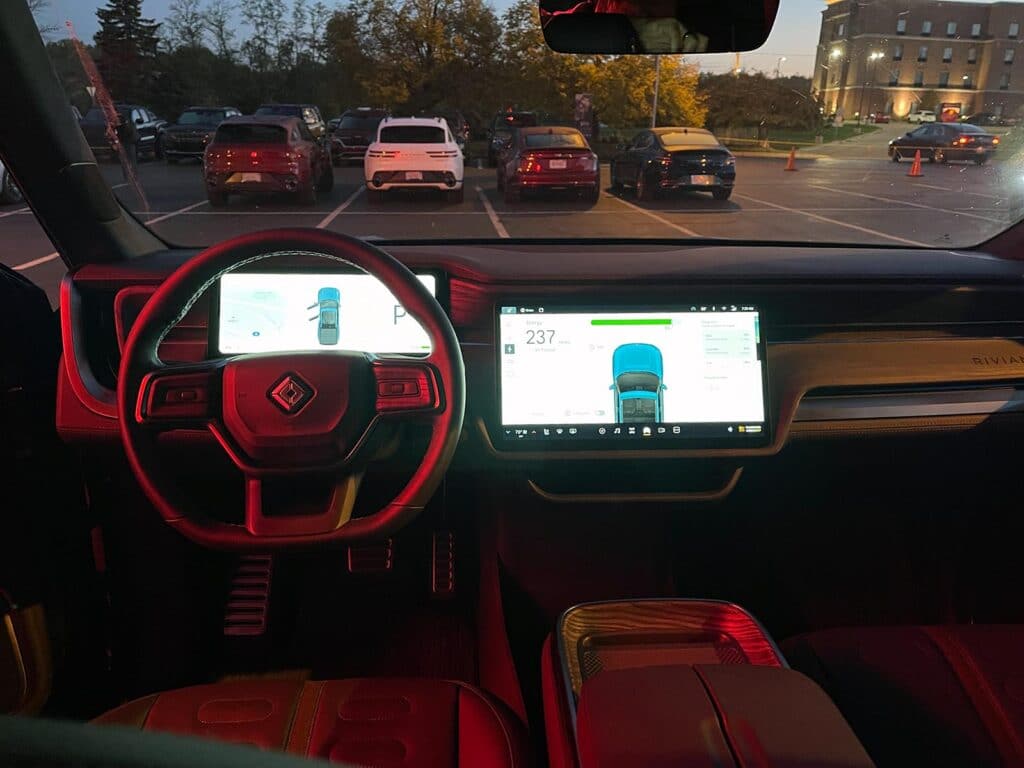
The Rivian R1T has a sleek and sophisticated look to its interior, adopting an open, almost Scandinavian-style design language that enhances its spacious feel. The Launch Edition features elegantly detailed wood accents on the instrument panel, though your eyes are likely to be drawn, at least initially, to the truck’s two large video displays.
There’s a brightly lit screen behind the steering wheel replacing conventional analog displays, and it reconfigures itself, as needed, depending upon the mode the truck is operating in. A wide touchscreen stretches across the central IP and operates virtually all vehicle functions, from climate control to navigation, as well as the positioning of outside mirrors and steering wheel. The only manual controls are found on the steering wheel itself.
The seats are nicely detailed and use a vegan material, rather than conventional leather, though you’d be hard-pressed to tell the difference. Rivian also uses recycled materials for the headliner and floor mats that can be easily washed out after a day at work or on the trail. A massive glass roof completes the look. Rivian claims it filters out most UV light and limits the cabin’s heat load on hot days — something I didn’t have a chance to confirm.
Powertrain
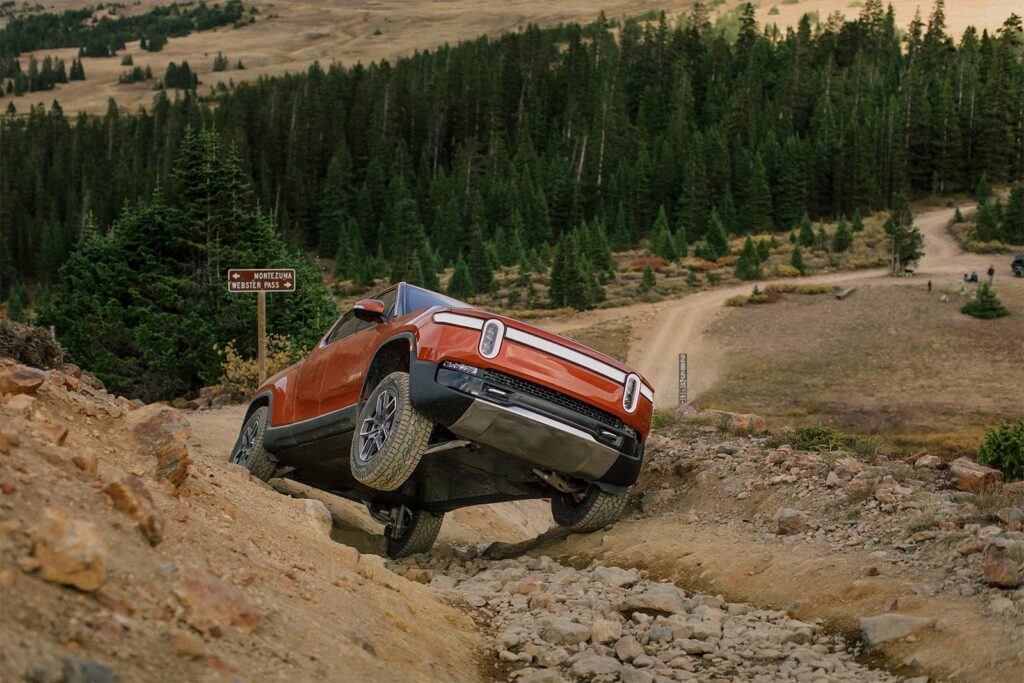
R1T’s platform — which will be shared with the R1S sport-utility vehicle — allows for a variety of different powertrain configurations. In the Launch Edition, there are two drive units, each consisting of two individual motors, so that means one motor per wheel. That layout has numerous advantages when it comes to distributing torque where it is needed at any given moment.
Rather than having to apply individual brakes or use complicated differential systems, everything is done through software. That results in a very responsive all-wheel-drive system, as well as torque vectoring. The latter reduces power to the inside wheels to help improve handling while cornering.
While I did have the opportunity to put the Rivian on some rough dirt roads, a colleague recently experienced the R1T on some serious trails. Simply by shifting to off-road mode, the truck raised itself up to its full 15-inch maximum height and adjusted the response of throttle and motors. The result was something akin to what you’d expect from a conventional pickup with a two-speed transfer case operating in the 4-low range.
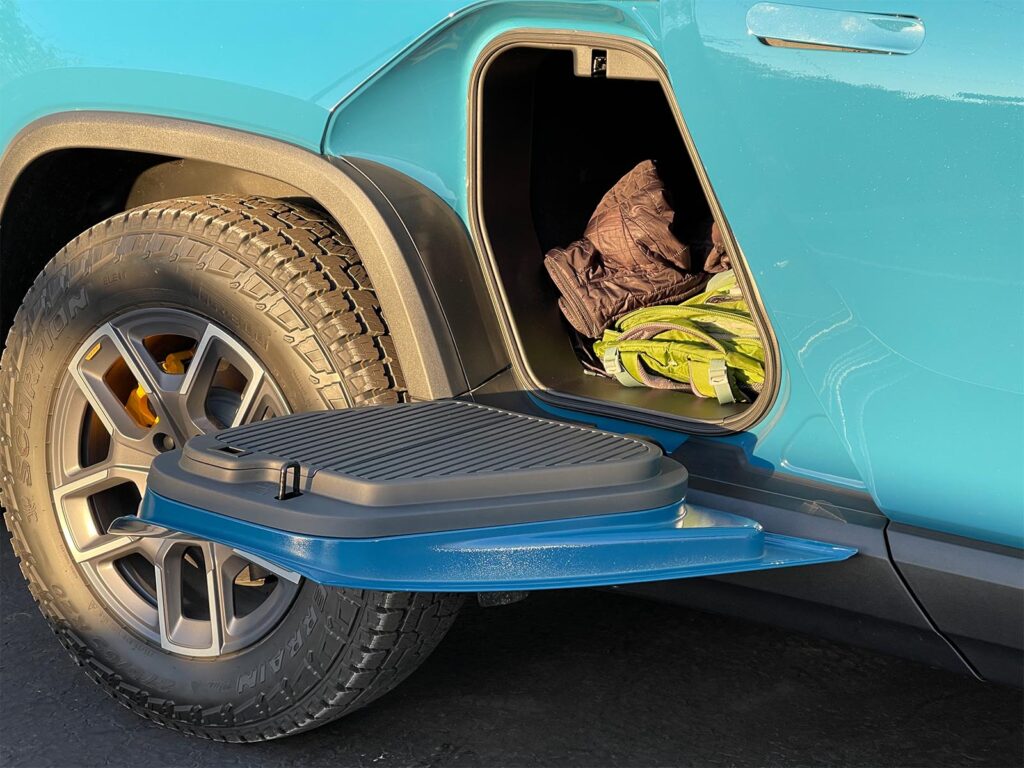
The Launch Edition produces 800 hp and about 900 pound-feet of torque. In Sport Mode, the suspension hunkers down as low as 5 inches off the ground, throttle response quickens and, should you mash the throttle, the truck will hit 60 in a mere 3 seconds. It doesn’t slow down at that point. I kept pushing til I (quickly) approached triple digits. Rivian isn’t releasing a top speed though Britain’s Top Gear reported a figure of 120 mph. If accurate, that would slightly exceed both the Ford Raptor and Ram TRX.
The Launch Edition’s 135 kWh battery will deliver an EPA-estimated 314 miles of range. As earlier noted, that will vary significantly depending on whether you are towing, carrying a large load in the bed, pushing the truck to the limits of its performance — or driving in winter. According to TheDetroitBureau.com’s calculations — backed by AAA research — BEVs tend to lose about 40% of their range when the mercury drops to 20 degrees Fahrenheit.
Interestingly, the multifunction screen allows you to limit recharging to 70, 85 or 100% of battery capacity. The higher you go the more likely you are to degrade the pack over time.
The automaker claims you can get up to 140 miles of additional range when plugged into a high-speed public charger in 20 minutes. A built-in 11.5 kilowatt 240-volt charger can top the pack up overnight, Rivian also said, the system yielding an additional 16 miles of range per hour. So, if you do run down to zero, you could be sidelined for a while, or need to find that quick charger.
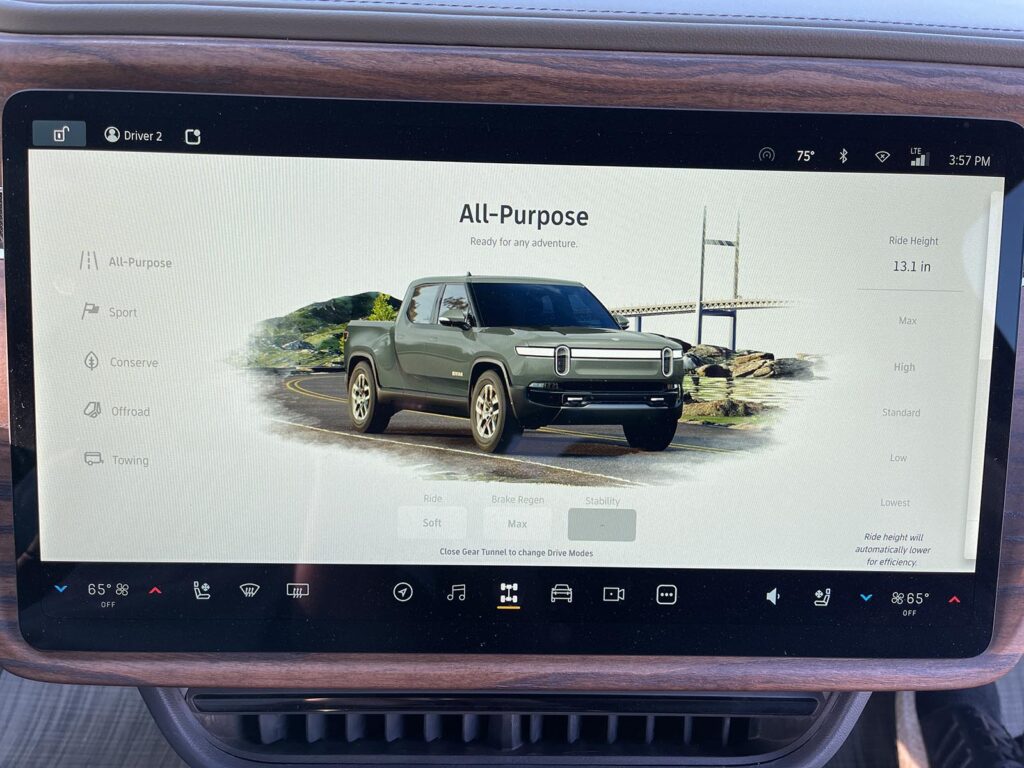
Safety and Technology
The technology inherent in the R1T’s drivetrain is impressive. One of my favorite features is its One-Pedal Drive function. With this activated, the truck maximizes the amount of energy recaptured during braking and coasting and you simply have to back off the throttle to slow down markedly. You can even come to a complete stop without ever having to touch the brake pedal. Rivian isn’t the only automaker offering One-Pedal, and a study released this month by J.D. Power found it the favorite feature among EV owners.
The truck has an array of exterior camera, radar and sonar sensors and these take its standard adaptive cruise control up another notch. Double tap the shift lever and it activates Level 2 autonomy. You still need to maintain a light touch on the steering wheel but the system effectively steers the big truck, while also maintaining a safe distance from surrounding traffic.
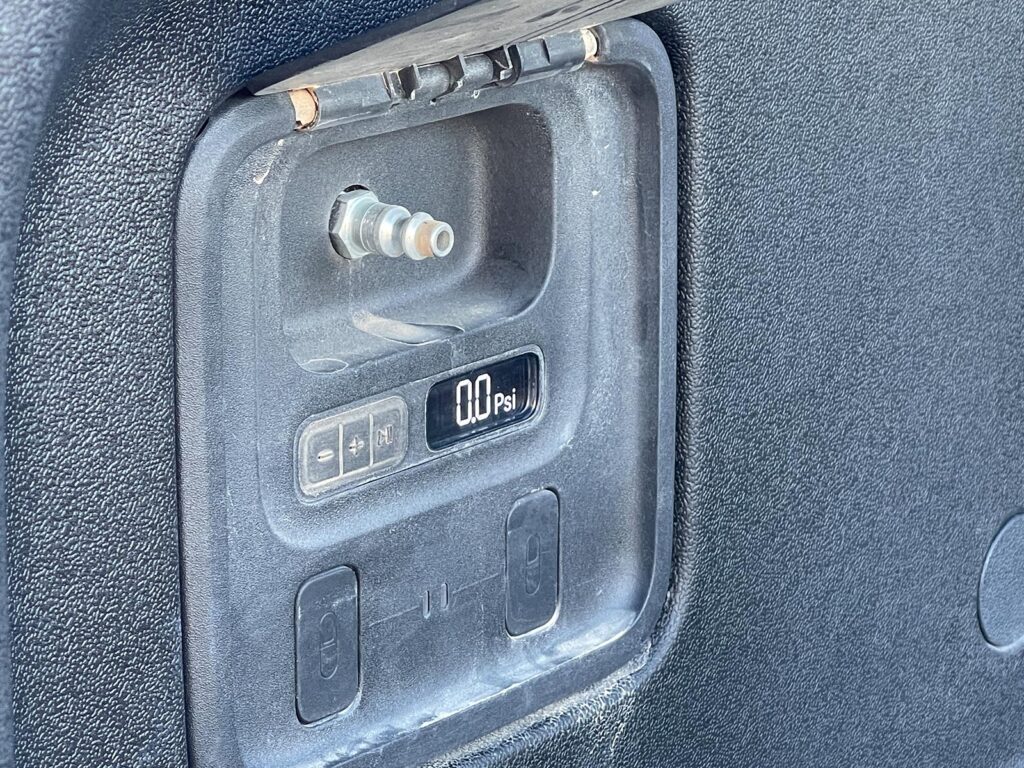
The system is effective but is not up to the true hands-free capabilities of General Motors’ new Super Cruise. Nor can it automatically change lanes simply by tapping the turn signal, like BlueCruise. If I have any real complaint it’s that changing lanes will knock you back into regular adaptive cruise control — and it does so a bit abruptly, almost with a slight shudder.
Annoyingly, if should you need to restart active cruise or the more advanced, semi-autonomous system, perhaps after tapping the brakes, there is no traditional “resume” button.
And that raises a question that comes up constantly, across the auto industry: how much of a vehicle’s controls should be handled through the touchscreen? In the case of the R1T, Rivian’s answer is pretty much “everything.” There are familiar, manual controls for the seating, and two sets of multi-function controls on the steering wheel. But, there isn’t a volume knob and even adjusting your outside mirrors and steering wheel position is handled via the big touchscreen. To Rivian’s credit, it’s easy to get where you want on the touchscreen, but I’d still like a few more manual controls.
Driving Impressions
Here’s where the R1T shines. I have driven dozens of battery-electric vehicles throughout the years, from early models like the GM EV1, up to some prototypes for products still as much as a year from production.
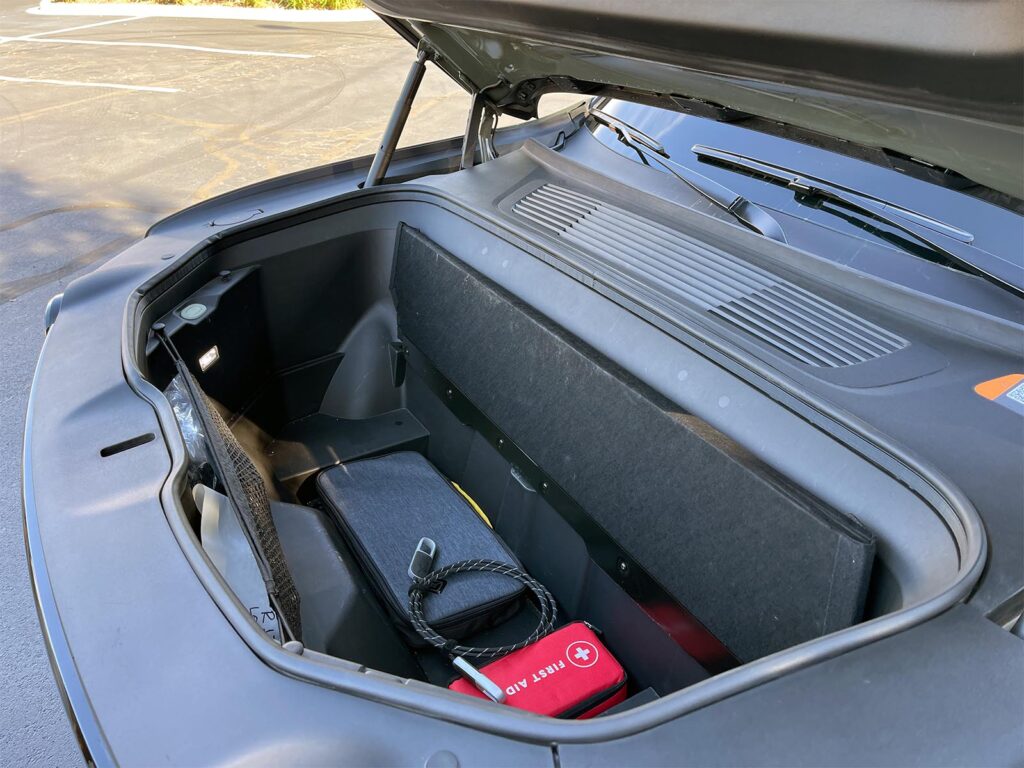
Yes, I have a few niggling complaints about the lack of traditional controls and the adaptive cruise control, but the Rivian R1T stands among the most refined and well-executed BEVs I have experienced to date. That covers both the refinement of the vehicle from a fit-and-finish perspective to its manners on the road.
Start it up and the R1T is simply a joy to drive. It shifts into gear intuitively and eases out onto the roadway as smoothly as any luxury vehicle I’ve driven. But when you mash the throttle, hang on tight. What I experienced was a giddy, visceral rush, in line with some of the highest performance sports cars I have ever driven. Indeed, this big truck is notably faster off the line than many of those exotics. The latest-generation Porsche GT3 hits 60 only 0.3 seconds faster.
As with virtually all BEVs, the drivetrain has a single gear, so acceleration is smooth and uninterrupted, however long you wait before lifting off the throttle.
Meanwhile, Rivian has done a solid job of giving each of the truck’s drive modes distinctive characteristics, whether hunkering down on the highway, or rising to full ground clearance and then sucking up the bumps on a dirt road.
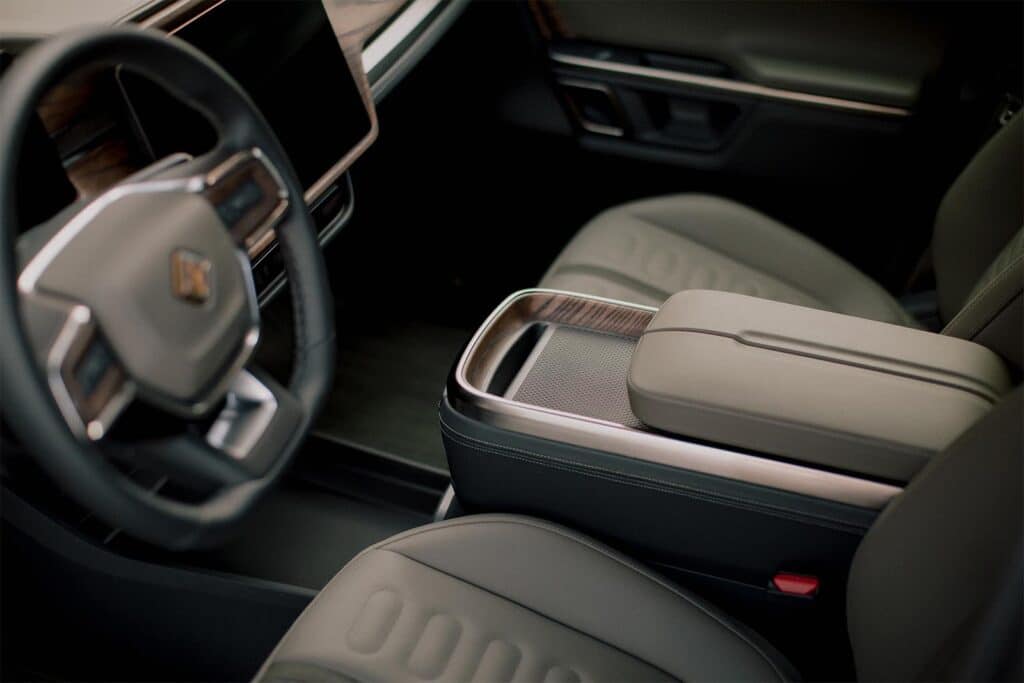
You get just the right amount of steering feel, and the big truck responded willingly to my inputs without being twitchy while doing high-speed maneuvers. Cornering proved particularly impressive, thanks to having the big battery pack under the load floor, resulting in a low center of gravity.
I can only look forward to spending more time in the R1T, including a future run at my favorite off-road park in Holly, Michigan.
Wrap Up
If this is what Rivian can deliver its first time out of the blocks I can only imagine what’s to follow. At a starting price of $73,000 for the R1T Launch Edition, you get a lot for your money right now. And there will be more options to come, notably including the long-range, 180 kWh battery pack.
To bring the 800-pound, all-electric gorilla into the picture, the Rivian R1T appears, at least for now, to have avoided all the quality problems that Tesla products continue to suffer from. Everything appears to be bolted together properly. There are no bubbles or flaws to the paint, or uneven gaps between body panels. And, but for the over-the-top design to what Tesla is planning, I just can’t imagine what its Cybertruck would do to better what Rivian is delivering.
There are, of course, other options coming, including the Hummer and the Lightning and, later on, electric pickups from Chevrolet, GMC, Ram and other startups. But Rivian has clearly set a high hurdle for the rest of the industry to clear.



